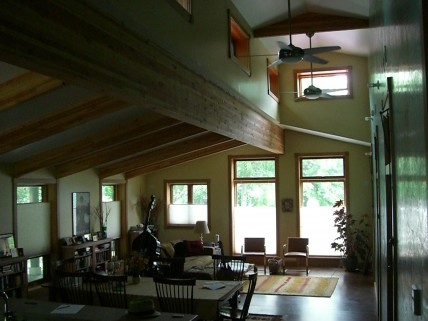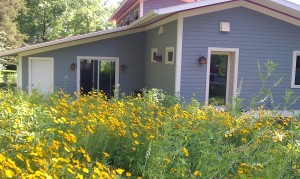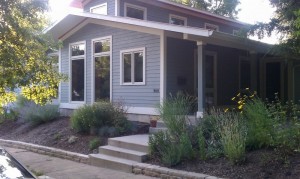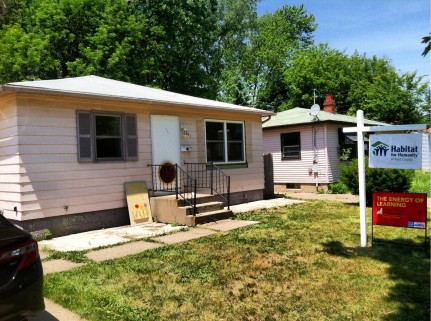Matchbox House LEED Platinum Certified – Ann Arbor
The project started out with an intent to design LEED certified which is reflected in its unconventional design. The project was modeled after a matchbox and was designed to have four inner quadrants that slip past on another withing the out sleeve of the house, all on top of
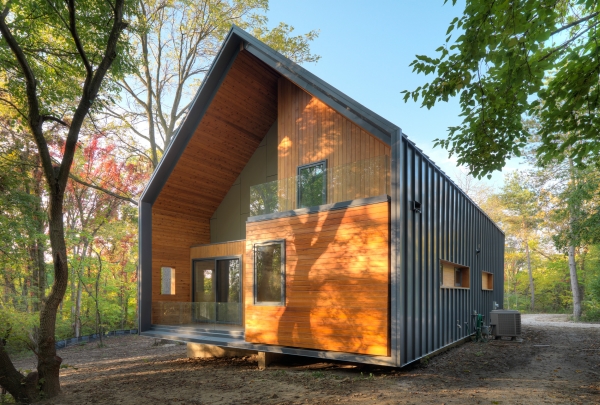
2216 Hickman Ann Arbor, Michigan
a raised foundation. The Matchbox’s compact design contributed to it’s LEED Platinum certification as there was less conditioned area to work on. The architect gathered information from other contractors experienced in green building practices in order to produce a home outside the norm. The result was distinctive, efficient, and compact home surrounded by natural, permeable turf minimizing the impact of the house on the surrounding environment.
The house has four bedrooms, 1,738 sf of conditioned space and a one car garage. It has received LEED Platinum Certification. It has a HERS rating of 47 and many notable features, including FSC wood, reclaimed trim from demolished Michigan barns in the region, no conventional turf (no irrigation) and low flow plumbing fixtures. The house has no attic or basement so upstairs rooms have dramatic ceilings that begin at 3’-0” and end at 16’-0” with an angle ceiling matching that angle of the roof.
No conventional turf or irrigation system was installed around the home, and all fixtures and fittings (toilet, faucets, and showers) are very high efficiency, reducing the site’s water demand by 78%. The wood used in the cabinets, stairs, closets, doors, and upstairs floors are all FSC certified. The house itself is much more compact than a standard house, so much that the LEED threshold dropped by 10 points. The kitchen counter tops and decking are constructed are composite from recycled materials.
The home’s unconventional design earned it 1st Place in Detroit Home Magazine Design Awards 2013 for Contemporary House under 4,000 sq ft.
Project Details:
Location: Ann Arbor, Michigan
Clients: Azar and Hormoz Alizadeh (the house currently is rented out to tenants, it is not currently occupied by the owners)
Project Type: Single Family
Conditioned Space: 1,738 sq ft.
Bedrooms: 4
Bathroom: 3
Lot Type: Infill
Construction Type: Custom
HERS Rating of 46, expected savings of 54% with a 5 Star+ Energy Rating
44% of Construction Waste Diverted from Landfill
Key Features:
- 2 kw Solar Panel on roof, reducing energy costs by 18%
- Wall Insulation R-Value of 29
- Air Filtration rate, MERV 15
- Reduced water demand by 76%
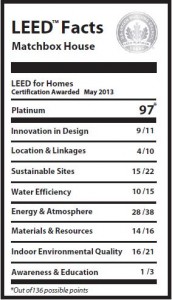
- Compact home for minimal site impact
- No irrigation system or conventional turf
- FSC certified cabinetry, stairs, closets, doors, and upstairs flooring.
- Energy Star certified appliances and light fixtures
- 2 ton heat pump/ERV
- Appropriately sized 40,000 Btu furnace
- Low flow toilets, faucets and showerheads
Project Team:
Brian Halprin (Green Building Services, Pllc)
Naseem Alizadeh (Bureau for Architecture and Urbanism)
Tad Krear (Landscape architect)
Cory Johnston (Structural engineer)
Matt Snider (Mechanical Engineer)
Photo gallery containing before, after, and during construction pictures:
The Matchbox House: Bureau for Architecture and Urbanism
Feature in Architect Lab’s Online Magazine
2216 Hickman (Matchbox House) Project Profile


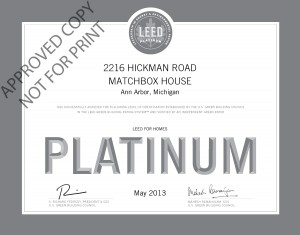
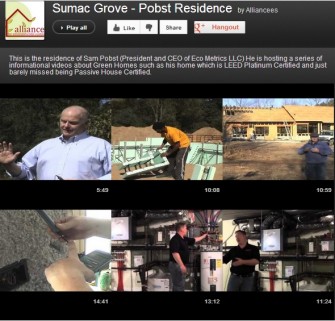

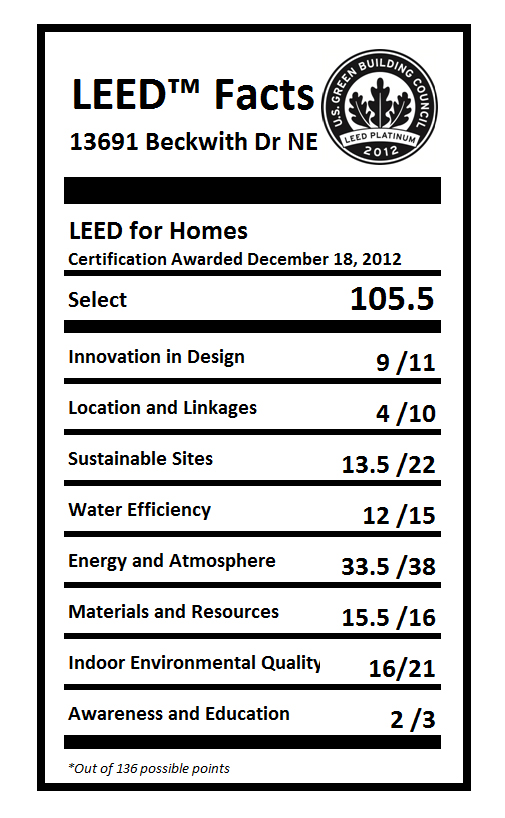
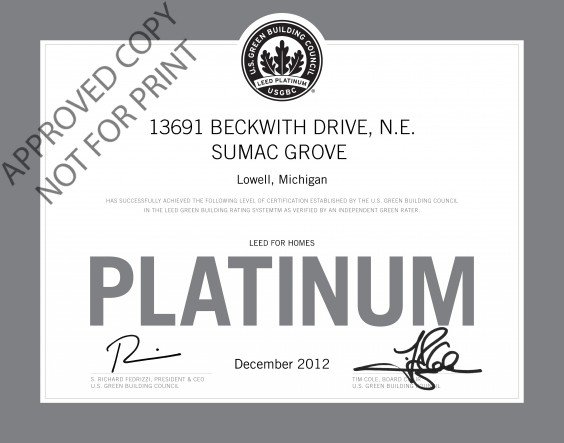 Recorded 1 Hour Webinar on the entire project – 1 AIA/GBCI
Recorded 1 Hour Webinar on the entire project – 1 AIA/GBCI 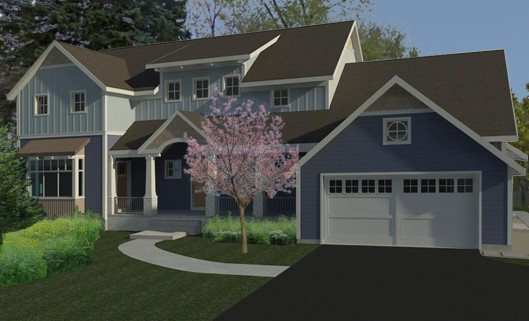
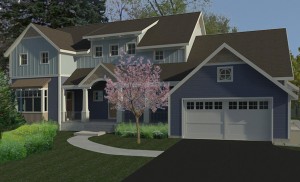

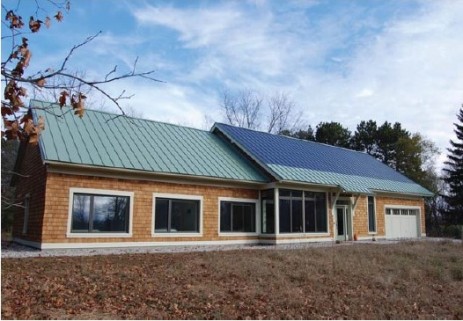

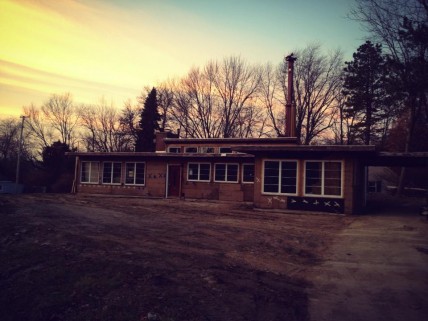
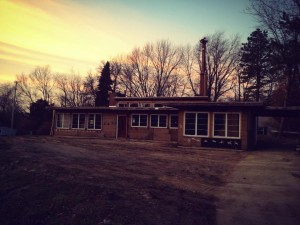
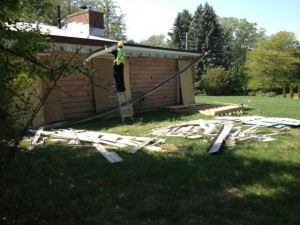
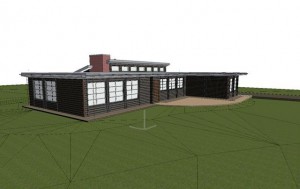


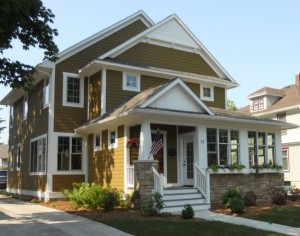 When Brian and Jeremy vanEyk (Vice President) were asked about their commitment to building LEED, they responded that Cottage Home is committed to utilizing healthy, affordable, efficient, and durable construction practices that are already above code, energy star and even LEED at times. Brian says he considers LEED only one of the many tools in his toolbox. Other such tools include creative design, customer service, careful selection of materials, and creating a sense of place. In order to make it simple for the customer, Cottage Home uses a fixed price prior to starting construction which already includes LEED qualifications. This allows some of the cost of LEED certification to be absorbed by both the customer and through the Cottage Homes marketing budget. Brian believes this method works due to his design and construction teams working together throughout the construction process, which creates a feedback loop that fosters constant improvement. Including LEED certification into the final cost helps facilitate more sales than presenting each option with separate pricing.
When Brian and Jeremy vanEyk (Vice President) were asked about their commitment to building LEED, they responded that Cottage Home is committed to utilizing healthy, affordable, efficient, and durable construction practices that are already above code, energy star and even LEED at times. Brian says he considers LEED only one of the many tools in his toolbox. Other such tools include creative design, customer service, careful selection of materials, and creating a sense of place. In order to make it simple for the customer, Cottage Home uses a fixed price prior to starting construction which already includes LEED qualifications. This allows some of the cost of LEED certification to be absorbed by both the customer and through the Cottage Homes marketing budget. Brian believes this method works due to his design and construction teams working together throughout the construction process, which creates a feedback loop that fosters constant improvement. Including LEED certification into the final cost helps facilitate more sales than presenting each option with separate pricing.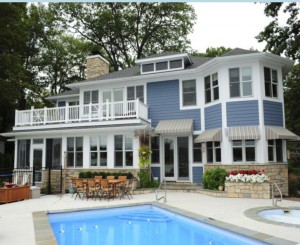 Since many homeowners today are educated and concerned about sustainability and environmental issues, many take time to study the details of LEED on the website of Cottage Home and take comfort in knowing LEED is a third party certification. Clients are aware of LEED’s achievements and credibility, and often wonder about how changes to the house affect the LEED certification level. Much of Cottage Home’s customer base is from the Chicago area where LEED is prevalent in their office buildings, and a result, many clients have experienced the advantages offered by LEED construction firsthand. These clients have often already invested in commercial LEED projects and are now ready to transition these same high standards to their personal lives. Jeremy decided to experience the benefits of LEED firsthand and chose to have his
Since many homeowners today are educated and concerned about sustainability and environmental issues, many take time to study the details of LEED on the website of Cottage Home and take comfort in knowing LEED is a third party certification. Clients are aware of LEED’s achievements and credibility, and often wonder about how changes to the house affect the LEED certification level. Much of Cottage Home’s customer base is from the Chicago area where LEED is prevalent in their office buildings, and a result, many clients have experienced the advantages offered by LEED construction firsthand. These clients have often already invested in commercial LEED projects and are now ready to transition these same high standards to their personal lives. Jeremy decided to experience the benefits of LEED firsthand and chose to have his Building on the lake front comes with complications such as extreme wind loads, humid changes, temperature fluctuation, and other variables. To overcome these challenges, Cottage Home uses high performance home measures to control the entire process though design, build, and some maintenance which allows more control of green features. Cottage Home designs and builds what is right for each particular home which may result in homes varying in different HVAC, insulation, passive solar heating, and various climate control systems. One particular feature that is commonly used in these homes, including Jeremys, is an ERV (Energy Recovery Ventilator). An ERV automatically exhausts stale air from the inside of the house and replaces it with fresh air from the outside. Another key feature used in many of the homes is a geothermal system. There are a few different types used, but all contribute to the energy efficiency of the homes in some way. Several techniques are used to increase water efficiency in the homes, such as tankless water heaters, which only heat water when necessary, water collection systems to help with sprinking and irrigation, and faucets and showerheads that work with less water than traditional ones. Insulation, as well as materials such as flooring, home furnishings and walls are all aspects that need to be carefully considered when building these homes.
Building on the lake front comes with complications such as extreme wind loads, humid changes, temperature fluctuation, and other variables. To overcome these challenges, Cottage Home uses high performance home measures to control the entire process though design, build, and some maintenance which allows more control of green features. Cottage Home designs and builds what is right for each particular home which may result in homes varying in different HVAC, insulation, passive solar heating, and various climate control systems. One particular feature that is commonly used in these homes, including Jeremys, is an ERV (Energy Recovery Ventilator). An ERV automatically exhausts stale air from the inside of the house and replaces it with fresh air from the outside. Another key feature used in many of the homes is a geothermal system. There are a few different types used, but all contribute to the energy efficiency of the homes in some way. Several techniques are used to increase water efficiency in the homes, such as tankless water heaters, which only heat water when necessary, water collection systems to help with sprinking and irrigation, and faucets and showerheads that work with less water than traditional ones. Insulation, as well as materials such as flooring, home furnishings and walls are all aspects that need to be carefully considered when building these homes.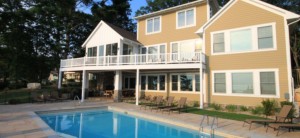 As leaders in the industry we asked Brian and Jeremy what they saw in the future of design and construction. Jeremy believes that being able to evaluate the effectiveness of high performance systems and insulation through energy bills is important. Along with water collection systems to reduce storm water runoff and help irrigate the lawn. Brian agrees that we should have a system to allow clients to ensure they are getting the most effective homes. He foresees homes that can be manipulated to meet the client’s needs at any given time. An example of this would be homes with the ability to accommodate a family of four, which can then transition to accommodate sleeping arrangements for twenty. Along with being able to better meet a client’s needs, he would like to see energy loads distributed to only sections of the house in use, as well as the ability for clients to control how energy is used throughout the home (on site and from satellite locations). Cottage Home sees one challenge to moving forward with these ideas is getting sub-contractors to approach basic air sealing, insulation, proper HVAC sizing, and design aesthetics with an effective mindset. Cottage Home has established themselves as innovators and leaders in the design of luxury LEED lake front homes. They continue to partner quality, design and the environment hand in hand to produce sustainability along our beaches.
As leaders in the industry we asked Brian and Jeremy what they saw in the future of design and construction. Jeremy believes that being able to evaluate the effectiveness of high performance systems and insulation through energy bills is important. Along with water collection systems to reduce storm water runoff and help irrigate the lawn. Brian agrees that we should have a system to allow clients to ensure they are getting the most effective homes. He foresees homes that can be manipulated to meet the client’s needs at any given time. An example of this would be homes with the ability to accommodate a family of four, which can then transition to accommodate sleeping arrangements for twenty. Along with being able to better meet a client’s needs, he would like to see energy loads distributed to only sections of the house in use, as well as the ability for clients to control how energy is used throughout the home (on site and from satellite locations). Cottage Home sees one challenge to moving forward with these ideas is getting sub-contractors to approach basic air sealing, insulation, proper HVAC sizing, and design aesthetics with an effective mindset. Cottage Home has established themselves as innovators and leaders in the design of luxury LEED lake front homes. They continue to partner quality, design and the environment hand in hand to produce sustainability along our beaches.